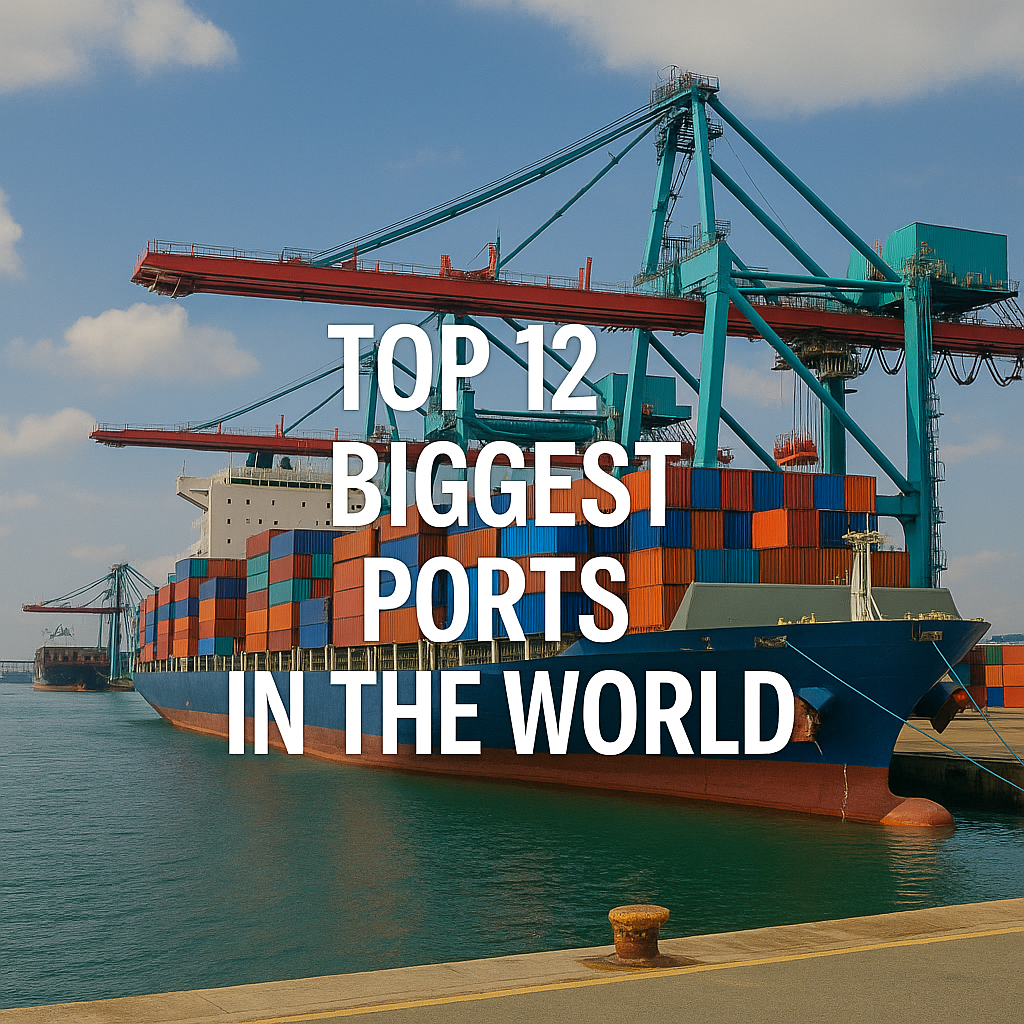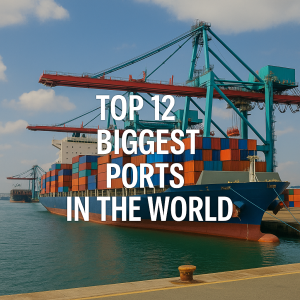Explore the top 12 biggest ports in the world by cargo volume and container throughput. Learn how these global maritime giants fuel trade, drive innovation, and anchor supply chain resilience.
Why the World’s Biggest Ports Matter in Modern Maritime Operations
In today’s interconnected economy, the scale of global shipping is staggering—over 11 billion tons of cargo and over 850 million TEUs (Twenty-foot Equivalent Units) were transported in 2023, according to UNCTAD. At the heart of this logistical feat are the world’s biggest seaports. These ports aren’t just massive in size—they are strategically vital, technologically advanced, and operationally critical for global supply chains.
From Asia’s container giants to Europe’s transshipment hubs, the largest ports on Earth are economic bellwethers, innovation testbeds, and sustainability pioneers. Their success stories reflect the growth of international trade, port automation, green shipping, and infrastructure engineering—all aligned with standards from the International Maritime Organization (IMO), IAPH, and BIMCO.
Let’s examine the top 12 largest ports by container throughput and overall cargo volume, highlighting what makes each port a cornerstone of global commerce.
Ranking Methodology
The ranking below uses data from authoritative sources including Lloyd’s List Intelligence, IHS Markit (S&P Global), Port Authorities, and UNCTAD. The primary metric is container throughput in TEUs, with additional insight into bulk cargo handling, technological infrastructure, and port depth.
1. Port of Shanghai, China
Annual Throughput (2023): 47.3 million TEUs
Shanghai has led the global rankings for over a decade. The port’s Yangshan Deep-Water Terminal, built on an artificial island, is a symbol of China’s Belt and Road maritime ambitions.
Key Feature: Automated terminals, AI scheduling systems, and the world’s longest sea bridge (Donghai Bridge).
Website: portshanghai.com.cn
2. Port of Singapore, Singapore
Annual Throughput (2023): 37.5 million TEUs
Singapore is a critical East-West transshipment hub. Its new Tuas Mega Port, scheduled for full operation by 2040, will consolidate all terminals into one seamless, smart port capable of handling 65 million TEUs.
Highlight: Integrated 5G smart systems, green corridors, and LNG bunkering.
Website: mpa.gov.sg
3. Port of Ningbo-Zhoushan, China
Annual Throughput (2023): 35.3 million TEUs
Combining container and bulk cargo dominance, Ningbo-Zhoushan is the largest port by total tonnage, moving over 1.2 billion metric tons in 2023. It supports China’s heavy industry and raw material imports.
Strategic Role: Bulk iron ore and crude oil gateway with deep-draft berths.
Website: portnb.com
4. Port of Shenzhen, China
Annual Throughput (2023): 30.6 million TEUs
Shenzhen’s port complex includes terminals like Yantian, Shekou, and Chiwan, serving tech-driven exports from the Greater Bay Area. It’s a key node in electronics and high-value cargo logistics.
Tech Note: Hosts automated cranes and blockchain-backed customs systems.
Website: portsz.com
5. Port of Guangzhou, China
Annual Throughput (2023): 25.6 million TEUs
Located in the Pearl River Delta, Guangzhou supports both containerized and break-bulk trade. Its proximity to manufacturing hubs makes it indispensable for supply chains spanning Southeast Asia and beyond.
Green Shift: Electrified berths and hybrid tugboat adoption.
Website: portgz.com
6. Port of Busan, South Korea
Annual Throughput (2023): 23.7 million TEUs
South Korea’s maritime powerhouse connects transpacific routes to Japan, China, and the Americas. Busan New Port features high-speed rail integration and eco-friendly terminals.
Academic Integration: Linked to Korea Maritime and Ocean University.
Website: busanpa.com
7. Port of Qingdao, China
Annual Throughput (2023): 23.4 million TEUs
Qingdao combines robotics, AI, and IoT technologies to maintain one of the world’s most efficient port operations. The fully automated terminal, launched in 2017, set the global standard.
AI Milestone: Fully automated yard with remote-controlled STS cranes.
Website: qdp.cn
8. Port of Hong Kong, SAR
Annual Throughput (2023): 16.7 million TEUs
Despite fierce regional competition, Hong Kong remains a vital logistics and transshipment hub with freeport status. The Kwai Tsing Container Terminals handle high-volume container exchange.
Challenge: Land scarcity and regional port competition from Shenzhen.
Website: hkmpb.gov.hk
9. Port of Tianjin, China
Annual Throughput (2023): 21.2 million TEUs
Tianjin serves as the maritime gateway to Beijing and Northern China. Its sprawling complex handles a mix of crude oil, LNG, dry bulk, and container traffic.
Climate Investment: Home to China’s first carbon-neutral terminal pilot project.
Website: port-tj.com
10. Port of Jebel Ali, UAE
Annual Throughput (2023): 14.2 million TEUs
Operated by DP World, Jebel Ali is the Middle East’s largest and most advanced port, supporting Africa-Asia-Europe connectivity. It also plays a vital U.S. military logistics role.
Innovation: Blockchain-backed customs system and LNG-ready berths.
Website: dpworld.com/jebel-ali
11. Port of Rotterdam, Netherlands
Annual Throughput (2023): 14 million TEUs
Europe’s largest port blends scale with sustainability. The Maasvlakte 2 expansion features some of the deepest berths and the most automated terminals in the EU.
Leadership: Hydrogen pilot projects and Smart Logistics Program (AI/IoT).
Website: portofrotterdam.com
12. Port of Los Angeles, USA
Annual Throughput (2023): 10.8 million TEUs
As North America’s busiest port, LA handles over 20% of all U.S. containerized imports. In tandem with Port of Long Beach, it is pioneering green supply chains and AI-integrated operations.
Environmental Role: Shore power adoption and emissions tracking under CARB and IMO guidelines.
Website: portoflosangeles.org
–
Case Study: Tuas Mega Port – Singapore’s Future-Ready Maritime Vision
Singapore’s Tuas Mega Port is the world’s most ambitious port consolidation project. Once complete, it will house 66 berths, handle 65 million TEUs annually, and operate on fully automated crane systems managed via a centralized AI command center. Supported by Inmarsat digital platforms and IACS cyber risk frameworks, Tuas is a global benchmark in port design and execution.
FAQ Section
1. What is the largest port in the world by container volume?
The Port of Shanghai holds the top position, processing over 47 million TEUs annually.
2. Why are so many of the biggest ports in China?
China’s global manufacturing dominance, infrastructure investment, and Belt and Road Initiative drive high cargo volumes and world-class port facilities.
3. How do ports manage such high volumes efficiently?
Through automation (e.g., robotic cranes), digital twins, predictive analytics, and integrated rail-road connectivity.
4. Are these ports environmentally sustainable?
Many ports are adopting IMO-aligned green strategies like shore power, LNG bunkering, and carbon-neutral terminals.
5. What’s the difference between TEUs and cargo tonnage?
TEUs measure container volume, while cargo tonnage includes all types of freight (bulk, liquid, break-bulk, etc.).
6. Which U.S. ports rank globally?
Port of Los Angeles and Port of Long Beach rank among the top 20, with high cargo throughput and advanced logistics infrastructure.
Conclusion
The world’s largest seaports are more than massive logistical hubs—they are barometers of trade, catalysts of innovation, and pioneers in sustainability. Whether it’s Singapore’s smart port, Rotterdam’s hydrogen corridor, or Shanghai’s deep-water expansion, these ports embody the future of maritime logistics. Their growth is intricately linked to evolving IMO regulations, global shipping alliances, and port-centric urban development.
Call to Action:
For maritime professionals, planners, or educators—explore how these mega ports function as engines of trade and templates for future port development. Track their evolution to understand the direction of the global maritime industry.
References
-
UNCTAD Maritime Transport Review (2024). https://unctad.org
-
IMO Smart Shipping Strategy. https://www.imo.org
-
Lloyd’s List Intelligence Port Rankings. https://lloydslist.maritimeintelligence.informa.com
-
Port of Shanghai. http://www.portshanghai.com.cn
-
Port of Singapore Authority. https://www.mpa.gov.sg
-
DP World. https://www.dpworld.com
-
Port of Rotterdam. https://www.portofrotterdam.com
-
MarineTraffic. https://www.marinetraffic.com


